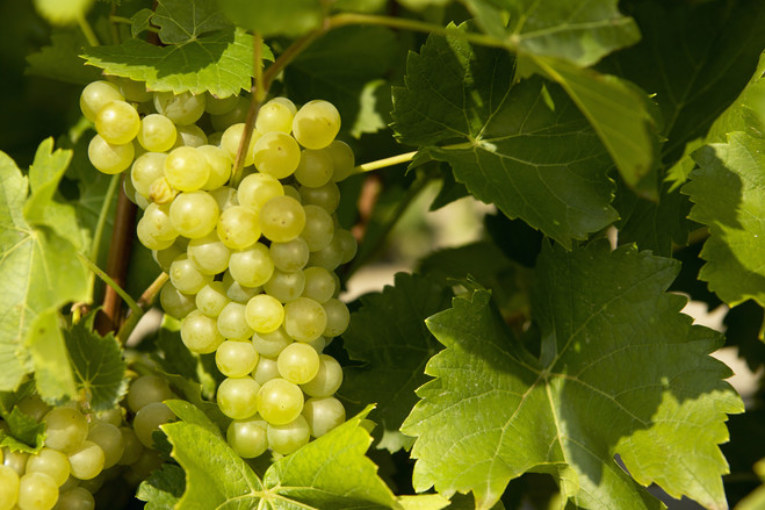
The Super Extra grape variety was bred by EG Pavlovsky, a breeder from the Rostov Region. To get a hybrid of berry culture, he pollinated Talisman and Cardinal varieties. In various sources you can find his second name - "Citrine." Zoned plant for cultivation in all regions of Russia.
It gained its popularity due to the excellent taste of fruits, resistance to diseases and adverse weather conditions.
Content
Grade characteristics

"Citrine" refers to hybrids with an early ripening fruit, 90-110 days. The plant is not exposed to most fungal and bacterial diseases, but a pest like phylloxera often damages leaves. Resistance to frost is average. The vine and buds do not freeze in the winter, if the air temperature is set not lower than -25 ° C. For pollination, it is not necessary to plant other varieties nearby, since the flowers are bisexual (the plant pollinates itself). After planting in the vineyard, the bush begins to bear fruit in the second or third year. Berries ripen by the end of July, or at the beginning of August, it all depends on the region where the plant is planted.
The yield from the bush is 20 kilograms. Ripe fruits can be transported over long distances without fear that the berries will fall off the stem. Use grapes for fresh consumption, making wine, jam, juice.
Despite the fact that the flowers are bisexual, berries may not form due to increased humidity. Therefore, try to plant seedlings in sunny places.
Description of the appearance of the plant and fruits
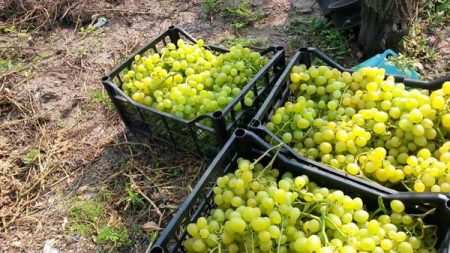
The bushes and root system of the grapes are strong. The plant is densely leafy. Leaf blades are five-lobed, not very dissected at the edges, painted in deep green. Strong shoots ripen in one year. Bunches are formed in a conical shape. The mass of one reaches 500-800 grams. Subject to all, without exception, the rules of agricultural technology, a bunch can grow up to one and a half kilograms. The clusters are not dense in structure.
The berries are tied round-oval. On average, they are formed in the length of 3-3.5 centimeters, and in the width of 2-2.5 centimeters. The mass of one reaches 5-10 grams. Fruits ripen not the same size. The skin is dense, covered with a wax coating on top. In technical ripeness, the berries have a green-golden color, and in full ripeness they acquire a rich amber-gold color. Taste harmoniously combines sourness and sweetness, but nevertheless sweet notes prevail, and sourness gives it freshness. The aroma is pleasant, tasters distinguish three persistent smells of grapes: nutmeg, caramel and grassy.
Advantages and disadvantages of berry culture
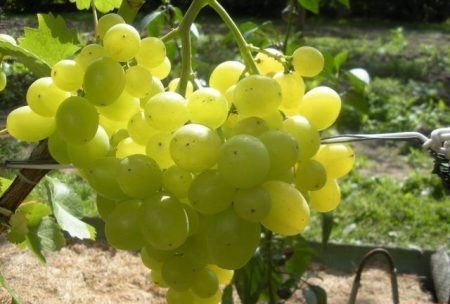
For many gardeners, Super Extra grapes have become a favorite. According to the collected reviews, it was possible to highlight the main advantages and disadvantages of the plant. The advantages include:
- stable fruiting every year;
- high productivity;
- resistance to most ailments;
- resistance to adverse weather conditions;
- long-term storage of the harvest, the ability to transport over long distances;
- can be propagated by cuttings and vaccinations.
The disadvantages are:
- the berries do not grow the same size, with unstable weather conditions, a strong “peeling” of the fruits is possible;
- regardless of the moisture of the soil and air, 30-40% of the berries crack at the tips, but do not rot;
- instability to attacks phylloxera.
Agricultural technology
Berry culture is not particularly whimsical to the growing conditions, but if you do not follow the simplest rules of care, you will not be able to get a decent crop. What do grapes need for normal growth and development?
Planting and growing grapes
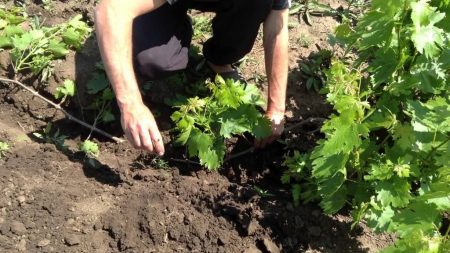
- Citrine can be grown on any soil. In cases where clay is on the plot, it must be made loose. Add peat and sand, for 1 m² you will need 2 buckets of these elements. He does not like grapes with strongly acidified soil. Reducing the acidity of the soil will help making: slaked lime, dolomite flour, wood ash.
- The place for planting a berry culture should be sunny and without drafts. Slight dimming from nearby buildings is allowed. The shadow does not affect the quality of the fruits and development. Place the plant closer to the fences or house no closer than 1 meter so that the root system has room to grow.
- A month before planting, prepare the selected area. Remove all weeds from the soil, remove debris. Dig a hole at a designated location, 80 centimeters wide and deep.
- Add 100 grams of superphosphate to the extracted soil, a liter jar of wood ash pulverized into powder, mix evenly and pour it back into the pit.
- You can plant seedlings in spring or autumn.
If groundwater lies close to the surface, then drainage is laid at the bottom of the pit. For drainage, use large gravel, expanded clay or just broken brick.
Stages of grape planting:
- Prepare a seedling purchased or grown independently before planting. Shorten the roots a few centimeters. Then, prepare a solution for soaking with any available growth stimulant. Experienced gardeners recommend using Kornevin (dissolve 5 grams of powder in 5 liters of water). Soak the root system for several hours immediately before planting;
- dig a prepared hole;
- pour the nutrient mixture into the drain. It is prepared on the basis of a bucket of humus and one kilogram of wood ash;
- place a seedling, spread the root system, fill it with soil, slightly compacting it. Be careful not to fall asleep on the root neck. It should be open 5-10 centimeters from the surface of the earth;
- pour the seedling with 20 liters of water;
- set a stake next to which you will tie the plant as it grows;
- Mulch the soil under the plant with rotted sawdust or straw so that the water evaporates less.
Berry crop care
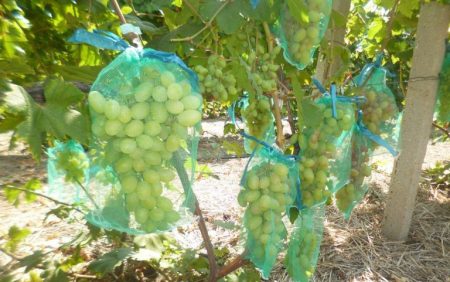
Care for grapes involves a number of points:
- Watering. Hybrid "Super Extra" refers to hygrophilous plants. After planting, a loose seedling, water the first month at intervals of one week. Starting from the second month after planting, irrigate once a day. Water consumption per bush is 15-20 liters.
- Weed removal and loosening. At least once a month near the plant it is necessary to remove weeds, as well as loosen the soil.
- Fertilizer application. In order for the plant to gain strength in the formation of large fruits, it must be fed at least twice. Make the first fertilizer before flowering, and the second, during the formation of the berries. For the first feeding suitable rotted manure (1 bucket per bush). For the second time, feed the plant with liquid fertilizer based on 50 grams of superphosphate, 50 grams of potassium sulfate, 10 liters of water.
- Cropping. Formative shoot removal in the fall, when the sap flow is completely stopped. Leave no more than 7 eyes on one vine. Ultimately, 4-6 main stems with 25-30 eyes should remain on the bush.
- Prevention phylloxera.In order to prevent a pest, in the spring, spray one of the recommended preparations - “Actellicum” or “Kinmiks”.
- Preparing for the winter. After pruning, remove the vine from the arches, gently bend to the surface of the earth. Make a mound of soil on top or cover with straw, and a film on top.
Watering stops three weeks before the berries ripen. If you neglect the recommendation, then the fruits can crack very much, and they will taste watery and not sweet.
Gardeners reviews
Angelina Vasilievna, 45 years old, Rostov Region.
Five years ago, my Super Berry variety replenished my collection of berry crops. Grapes are unpretentious in care. During the purchase process, the seller from the nursery indicated his susceptibility to phylloxera. He advised every spring, after the leaves bloom well enough to spray the plant “Karbofos”. And so, there were no problems with the garden plant.
Vladimir Mikhailovich, 56 years old, Kursk region.
I have been growing Super Extra grapes for 3 years. He began to bear fruit in the second year after planting. The clusters are large, but not dense, but the berries are large. I did not like the fact that when the clusters hang for a long time on the bush, the berries on the bottom begin to crack. I like the taste in grapes. After harvesting, it lasts up to two weeks if stored in the refrigerator.




 Non-covering winter-hardy grape varieties for Moscow region
Non-covering winter-hardy grape varieties for Moscow region How to keep the vine in winter
How to keep the vine in winter When can I transfer grapes to another place in the fall
When can I transfer grapes to another place in the fall How to cover and prepare grapes for the winter in the suburbs
How to cover and prepare grapes for the winter in the suburbs